
30 minute read
and expectations from the industry
from Waste Deep: An Exploratory Study of the Waste Generated by the Hospitality Industry in Hong Kong
2. CURRENT WASTE MANAGEMENT PRACTICES AND EXPECTATIONS FROM THE INDUSTRY
In this section, we look at the current waste management practices used by the hospitality businesses in our sample, as well as the barriers they faced or are facing when trying to implement more sustainable waste management practices and the main measures that, according to them, would help the hospitality industry in Hong Kong implement better waste management practices.
Advertisement
2.1 Choice of material and management of SFP waste
a) The importance of environmental considerations in choosing a particular type of material in outlets’ SFP mix
The choice of SFP material is important due to its influence on which type of disposal method it gives access to.
Among outlets who used SFP, the decision of the types of material used was, in most cases, mainly in the hands of the owner/franchise operator (14 outlets; 6 groups), while 6 outlets (2 groups) mentioned that the operation teams were the main decision-makers (i.e., Chef and F&B Department & Finances department), so the decision is mainly taken at a high level of management. One operator mentioned that, as their chef was involved in the process, they ruled out some of the material like the cheapest plastic containers due to the unpleasant taste it gives to food. This argument could be used as an added quality factor/incentive when suggesting other outlets to change their SFP material mix, and shows the importance of involving the operations team in such decisions, as they may incorporate lesser-known or other factors into the decision.
In terms of material used, our respondents predominantly opted for what could be considered as more “environmentally friendly” material given the material’s disposal method: all outlets reported using "compostable material" as part of their SFP mix. The second most common material was "paper", used by 14 outlets (5 groups) while 5 outlets (2 groups) reported using PET plastic.
In trying to understand the motivations behind choosing a particular type of material, our study reveals a predominance of environmental reasons compared with other market factors like the price (“It is cheaper than other types of materials”), convenience (“It is readily/widely available in Hong Kong”) or the characteristics of the material (“It has the best performance for its type of use: for example, it keeps the food warm or it doesn’t leak”).

Figure 8: Type of material used for SFP
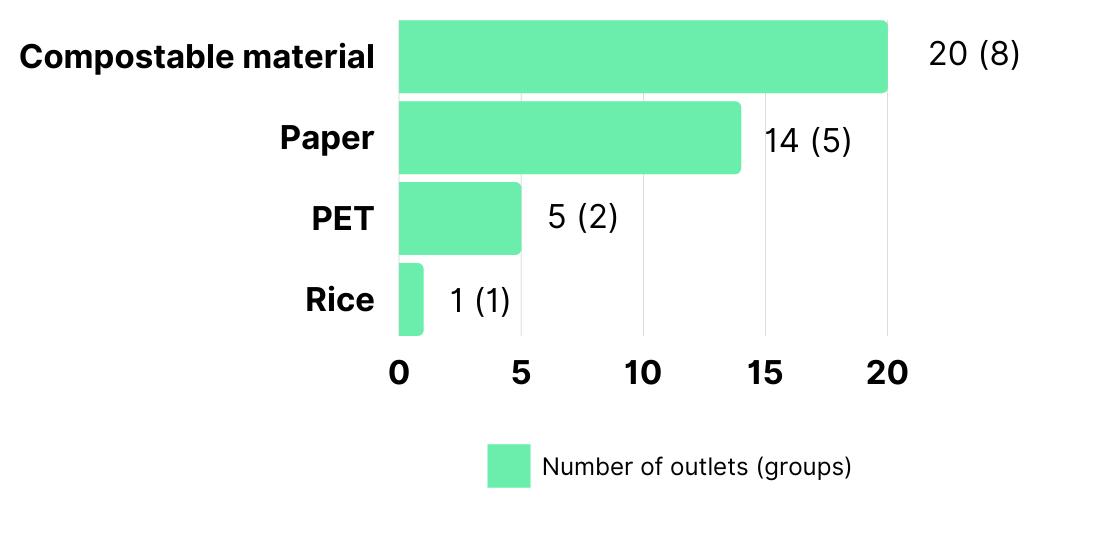
When given two options to choose from in order to describe why they had chosen compostable material, one single reason stood out: all outlets
responded they had chosen a particular type of SFP because “[they]
want[ed] to avoid plastic” (Table 5). The prevalence of this reason is such that 8 outlets (4 groups) chose this reason only instead of giving two, as the question invited them to. One representative of a hotel group specified in the questionnaire that the will to avoid plastic was even engrained at the group level, with a clear company policy stating “no single-use plastic in operations across the group”, including rooms.
Table 5: Two main reasons for choosing SFP material
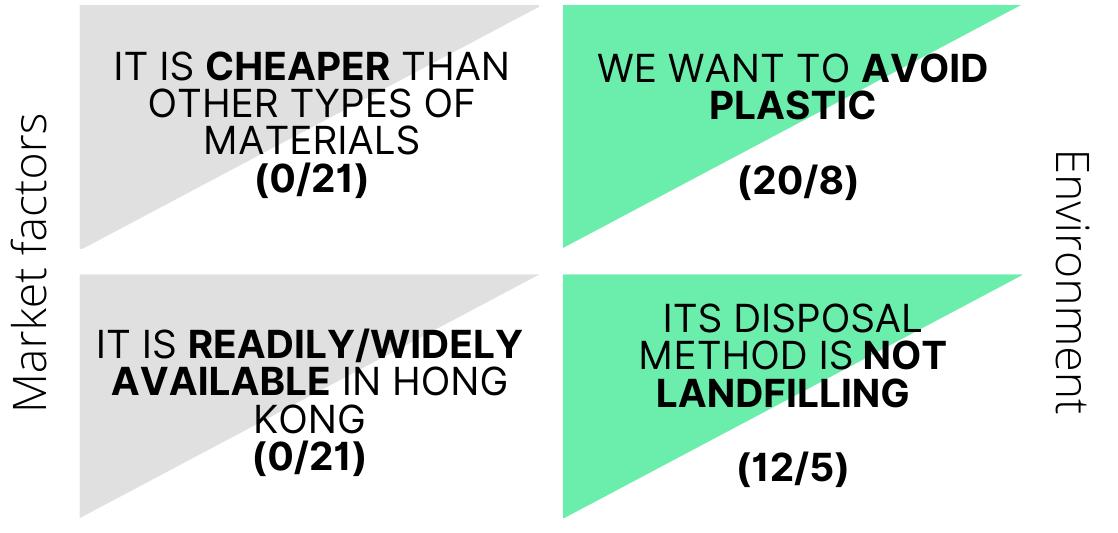
This exemplifies a change in mentality for some environmentally conscious outlets and groups, for which one specific aspect of sustainability is particularly important: the fight against plastic.
From an anthropological standpoint, some scholars have begun to call the current era the “Plasticene”, moving away from other human-induced environmental impacts that define the Anthropocene and solely focussing on a new era that is defined by an ever-increasing amount of plastic debris.31 The rising beacon of hope plastic once symbolised after its democratization in the 1950s and 1960s seems to have a whole new significance now, albeit mostly negative. Plastic became an illustration of the fact that our current society could be drifting towards what Ulrich Beck defines as a “risk society”: a society that fears its own creations due to the negative ecological and social impacts that they will have in the future.
Although there is an increasing awareness of having to implement systematic changes, the solutions that address plastic use may not counteract the risks. For example, biodegradable alternatives may lead to a higher carbon footprint and water usage. 32 A related example in our survey would be one of the participating groups having to ship biodegradable gloves from the United Kingdom to Hong Kong in order to avoid using plastic gloves. Considering the carbon footprint of transportation, it is very hard to know if this laudable solution to avoid plastic is better or worse from an environmental standpoint.

The rhetoric of plastic as the number one enemy is reiterated in the previously mentioned Government campaign "Plastic-Free Takeaway, Use Reusable Tableware", where the focus is clearly against plastic, and less on the negative impact single-use items and takeaway habits can have on our environment. The question of single-use packaging in Hong Kong,
regardless of their material, is a discussion that needs to be pushed
more into the public debate. On that matter, the Regulation of Disposable Plastic Tableware Public Consultation recently launched by the Hong Kong Government is a step in the right direction.
Avoiding the use of SFP in food service is the most effective way for hospitality businesses to eliminate SFP waste: all outlets were in favor of “BYO” campaigns and allowed guests to bring and use their own food containers for take-away. One outlet expressed concerns over hygiene though, and mentioned that guests would need to sign a waiver to discharge any responsibility in case the guest's container was contaminated. Such concerns should be kept in mind when promoting BYO campaigns in order to maximize the adhesion and support of the F&B community.
Except from avoiding plastic, the only other reason cited for choosing a particular type of material for an outlet’s SFP was "Its disposal method is not landfilling (e.g. we can recycle it or compost it)" (11 outlets; 5 groups), which is in alignment with the Government’s ambitions of “Zero Landfills by 2035” stated in the newly released Waste Blueprint for Hong Kong 2035.


b) The need for transparency and inclusion of the F&B sector in efforts to improve SFP waste management
The most popular disposal method for SFP in our sample was recycling. Out of the outlets that used SFP to serve food on-site,33 9 outlets (3 groups) recycled the SFP waste generated. Among them, 6 outlets (2 groups) recycled them through the provided Government bins, and 3 outlets (1 group) recycled them through an external contractor. After recycling, most of the remaining outlets used external contractors to compost their SFP (4 outlets, 2 groups). Only 2 outlets (1 group) disposed of on-site SFP in general waste.
What happens to the waste once discarded is a controversial issue in Hong Kong. A lack of trust exists between the public and the waste collectors who take care of the Governmental waste separation bins. Hong Kong citizens regularly witness recyclables being collected in a single bin and sent to landfill indiscriminately.34 A lack of transparency was also cited by interviewed guests when asked about their views on segregating SFP at a restaurant.
Almost all of them recalled and cited personal experiences when their
trust was broken by seeing waste collectors putting the separated waste back into one bin.
Figure 9: Disposal method for SFP

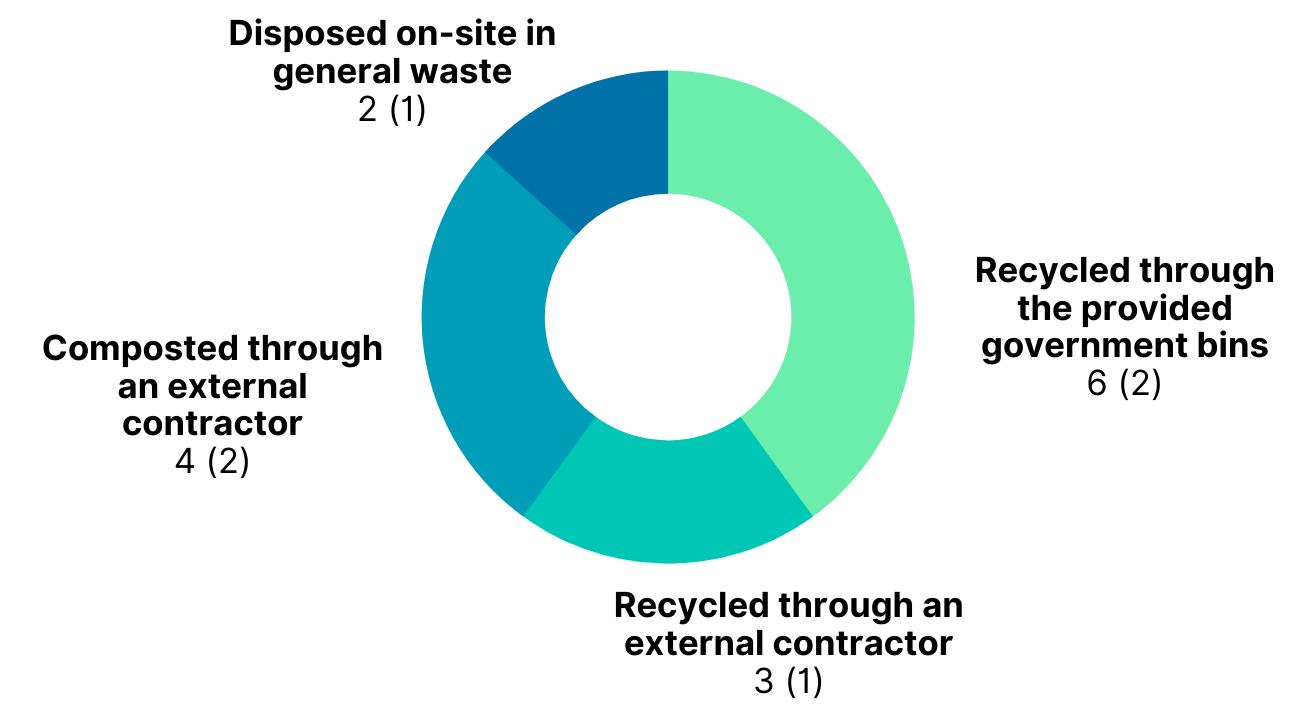
Given that transparency and trust in the waste management system are recurring issues for the general public in Hong Kong, we tried to assess to
what extent hospitality businesses in our sample were also sensitive
to the presence or lack of transparency when choosing their waste management methods, for both SFP and food waste. Thus, for participants who stated that they were using an external contractor to either treat their SFP waste or their food waste, we asked the following question: “If you use an external contractor to take care of your packaging/food waste, do you know or have you inquired how the external contractor is treating your single-use foodservice packaging/food waste? (where it is recycled or composted and what is done with the end-product afterwards)”. It appears that, out of the 7 outlets (3 groups) and 8 outlets (4 groups) who hired external contractors to respectively dispose of their SFP waste and food waste, all of them knew
or had inquired about how the external contractor was treating their
waste and the end-product after recycling or composting.
As such, it seems to be that transparency was an important factor for the proportion of our sample who hired an external contractor. Some outlets even included transparency of their waste management as an integral part of their communication with the customers by displaying in the restaurant what the composted food waste is used for, for example, or explicitly stating on their social media the contractor who takes care of their compostable food packaging. Pre-COVID, one group even published a monthly report with the amount of food waste diverted from landfill.

More generally, during the interviews, staff and members of the
management teams shared the public opinion regarding the lack of
transparency in Government-run recycling programs, with one person from the management team of an outlet stating, about the public rubbish bins that are separated: “I cannot remember I have ever seen a person coming back and collecting this rubbish with four separate containers. So they might as well have been cleaning those and actually it falls under the same container again. We don't know. Are they really putting the plastic in the plastic receiving container [...] or is it all going in the same pile and we just all separated it just to look like we care? [...] It's very hard to tell because we don't really see in front of our eyes what really happens to it.”
This lack of trust from both public and private actors is why Government initiatives such as the Plastic Recycling Pilot Scheme not only focuses on “process waste plastics more cost-effectively” but also on trying to “raise public confidence in the waste separation and recycling system”. The 2-year Pilot Scheme on Collection and Recycling Services of Plastic Recyclable Materials (塑膠回收先導計劃) was launched in January 2020 in three districts: Sha Tin, Eastern District and Kwun Tong. Community Recycling Centres and GREEN@COMMUNITY in these districts accept plastic containers, plastic utensils, and polyfoam. Some of these recycling centers regularly collect recyclables from commercial buildings. However, according to the Pilot Scheme, these recycling centers are meant to accept waste plastics from “non-commercial and non-industrial sources”, such as Governmental venues, housing estates and schools, thus excluding the possibility for hospitality businesses in participating in this scheme. This is representative of a broader trend regarding Government campaigns targeted at improving Hong Kong waste management system: they tend to target individuals' behavior and rarely include the commercial F&B sector. For example, there was no mention of partnering with or including the F&B or hospitality businesses in the “Waste reduction and Recycling” part of the 2020 Policy Address of the Environment Bureau.

2.2 Management of food waste
a) Segregating and measuring food waste
As stated in the introduction, food waste segregation is of utmost importance when it comes to building efficient waste management systems and infrastructures. Just like for their choices of SFP material mix, overall our respondents had already good practices in place when it comes to handling food waste: the majority of the outlets (18 out of 25 outlets; 7 groups out of 10) already segregated their food waste from general waste before the start of the research. Out of these 18 outlets, 12 of them (5 groups) separated from other non-biodegradable waste and 6 of them (2 groups) separated it into solid and liquid food waste. Only 5 outlets (3 groups) didn’t segregate their food waste. One group (3 outlets) reported that they didn’t segregate food waste because it was discarded with their SFP. However, as their SFP was compostable, their food waste was in effect segregated from other nonbiodegradable types of waste.
Figure 10: Segregation of food waste in the sample
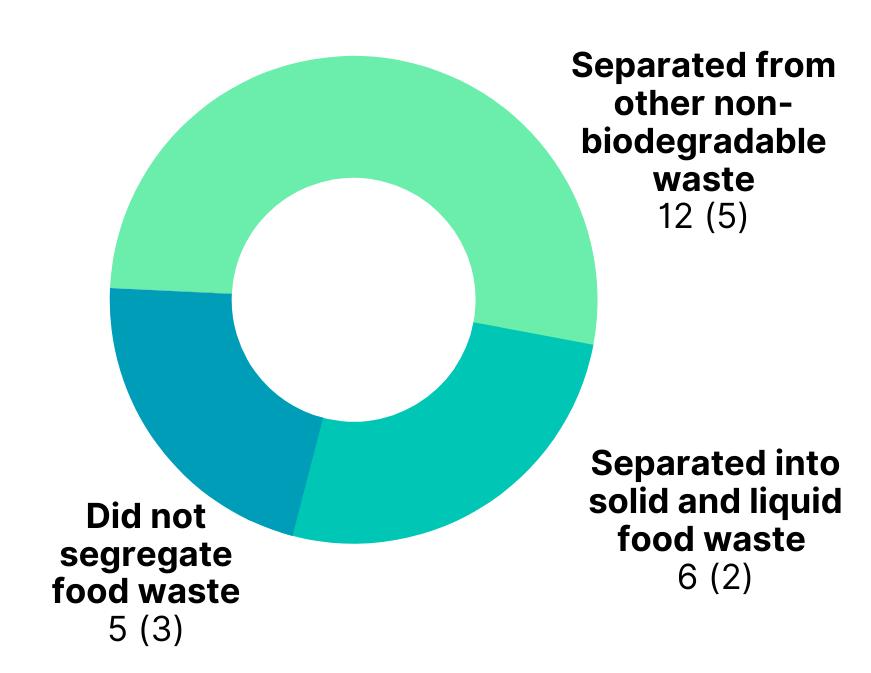

Two outlets started segregating food waste for the sake of the research, and we could then gather insights from the staff regarding this new habit.
The feedback from the staff during the interviews was mainly positive
towards waste segregation: all staff interviewed at these two outlets found that segregating food waste was relatively easy, mentioning during the interviews that “It was very easy to put the garbage and the food separately”. As such, in our case, staff’s lack of support or adherence wasn’t a main obstacle for segregating food waste.
Actually, staff at multiple outlets were enthusiastic about continuing waste segregation, and one group’s owner mentioned that staff members were inquisitive and curious about the next steps forward: ”[...] what they ask[ed me] as well is “What is going to happen next?” which is good because [the staff is] like, ok, if we’re doing that, why aren’t we continuing, and if we are not continuing, why? And what could we do to continue [...]?”.
Whether the establishments continue segregating food outside the trial run period was instead a matter of space, funds, and willingness of the establishment’s operator or owner. The barriers of implementation for better food waste management will be further explored in Section 2.3.

Segregating waste, both food waste and SFP, was not a problem for the guests either. Interviews of guests at establishments which require guests to separate their waste themselves found it easy and understandable: “I enjoy it. I think that’s fun. It’s like: This goes there, this goes there, and like, it’s fun,” said one guest during an interview.
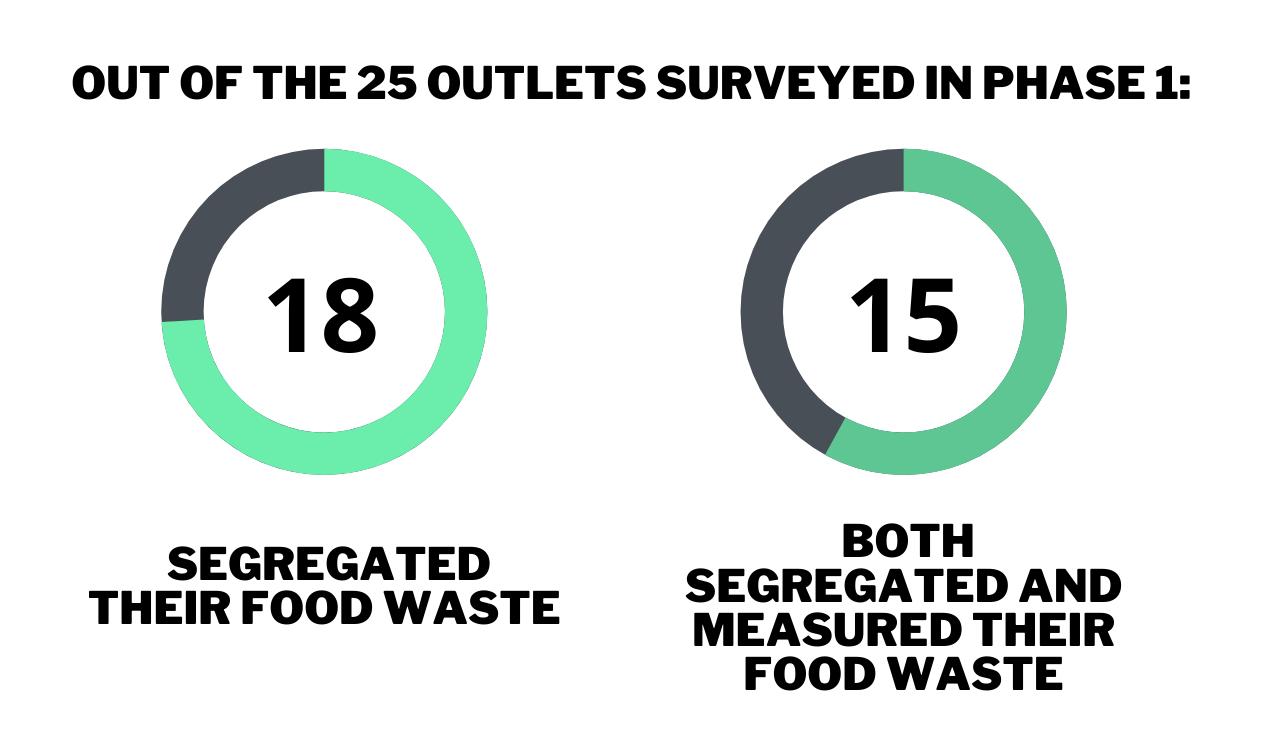
More than just separating food waste, many outlets also measured food waste. Food waste measurement is a first step towards reduction, as it provides insights on the amount of waste, but also the sources of food waste— like kitchen waste, spoilage, and customers’ plates waste—and allows to identify avoidable and non-avoidable food waste. It also helps hospitality businesses set food waste reduction targets and act meaningfully.35 Out
of the 18 outlets that segregated food waste, almost all of them (15
outlets, 4 groups) also measured it, showing how important segregation is in order to allow for food waste measurement.
COVID-19 has also been a factor in starting food waste measurements: there was one group among our respondents who actually didn’t segregate but did measure their food waste. As the two outlets of the group were coffee shops, they could easily measure the items prepared but not eaten by counting them. The reason they started measuring in the first place was because of the loss of revenue it represented, something that made a difference in difficult COVID-19 times, which reaffirms the business case of reducing food waste in hospitality businesses, as presented by the movement Champions 12.3.
Surprisingly, all staff members mentioned that the food waste measured was not as much as they had expected, which is discordant with previous studies that tend to show that, when it comes to food waste, people tend to underestimate the food waste they generate and expect to waste less than what they actually throw away.36 Interviews clearly indicated that
segregating and measuring food waste makes one more aware of what
is thrown away and what is not. Even though staff members were satisfied with the amount (or lack) of food waste, they agreed that, in addition to the existing food waste management measures, more could be done to reduce food waste generated by guests. “[U]sually, [...] we don’t waste that much in the kitchen,” mentioned one kitchen staff member who believed that most food wasted was generated by the guest and wanted to highlight this aspect of wastage. “[We are] quite advanced but there’s of course always room for improvement,” mentioned another waiter at the same outlet.

b) Engaging staff in food waste monitoring and reduction
Forming habits for better waste management is also dependent on the social and cultural environment staff find themselves in. Due to a staff member’s constant mention of “we” instead of “I” one could deduce a healthy kitchen staff unity which would help the formation of habits.
A phenomenological study published in 2008 with 12 participants deduced that the phenomenon of “belonging at work” consisted of six elements, two of which fit remarkably well when talking about how kitchen staff unity promotes loyalty towards the group’s or outlet’s philosophy related to sustainability.37 For a new individual arriving in the team, the first element is to be invited by an established individual to participate in learning how to engage with the work culture. For that, training needs to be provided for the individual to learn and grow (the importance of training will be explored in more details in Section 3.1). The second element is that, once a certain understanding of the culture is attained, a trusting bond can start forming which increases commitment to the values and attitudes that are upheld by the group or the outlet.
During our interviews, one hospitality group was actively incorporating
staff in major decisions and changes pertaining to improving
sustainability practices but directly impacting their work. Staff would then be involved in the way the outlet would operate, providing an opportunity for the team to work together and heighten the transparency between staff and the franchise operator.

On that topic, the founder of the hospitality group mentioned that “[...] if I am going to implement things that I know are going to have an impact on the way [my staff] work[s], then I am going to try to have a talk with them first, and try to understand if it is implementable or not, and how. [I will] try to get them onboard first, before I make some drastic changes [...]. It is trying to find solutions together, because at the end of the day, [I am not the one who is] doing the recycling, it is them, right?”. Thus, promoting a healthy and trusting bond between staff members and operators promotes a feeling of loyalty towards the overall philosophy, which in turn improves habits and attitudes.
Habits and attitudes can however be influenced by external factors of which the outlet or group has no control over. Staff members might possess different motives depending on their cultural and generational background. One restaurant owner described that, in their 20 years of working and training staff, there were some sustainability habits that were harder to convey to the staff, despite the training provided and the general philosophy embedded in the restaurant’s DNA. For example, the restaurant being a vegetarian one, the owner explained that Chinese or Western staff were more receptive to the idea of giving up meat, compared with Nepalese or Philippino staff for example, and that younger staff were more willing to change their own habits.
Changing habits at the restaurant can also be made easier if the staff can implement these changes at home as well. For recycling for example, the same restaurant owner acknowledged that a big portion of the Nepalese community in Hong Kong do not live in housing estates; where recycling is made more convenient. Thus, before citing cultural differences as the main factor to explain a certain behavior, external factors such as housing
inequalities in Hong Kong and the unequal availability of recycling
and sorting facilities should be considered. An outlet can facilitate an environment where recycling and sustainability choices are easier to make, but values and behaviors of staff can still be shaped by other social factors, such as their living environment. This shows that, no matter how much education is provided, at the restaurant or elsewhere, if the environment makes change complicated and difficult, then habits cannot be adopted properly nor on a large scale.

c) Food waste disposal methods
Just like for the material chosen in a SFP mix, the range of options for different food waste disposal methods depends on the existence or absence of segregation of food waste at the outlet, as some disposal methods like digesting or composting are only feasible with a rigorous waste segregation. Following the high proportion of outlets segregating food waste, it is not surprising to find that respondents in our sample mainly used digesting and composting as their main waste disposal method. Out of 21 outlets, 16 (6 groups) either digested or composted their waste. The remaining 5 outlets (3 groups) disposed of their waste in the general waste and correspond to the outlets that didn’t segregate at all their food waste.
Figure 11: Food waste disposal methods
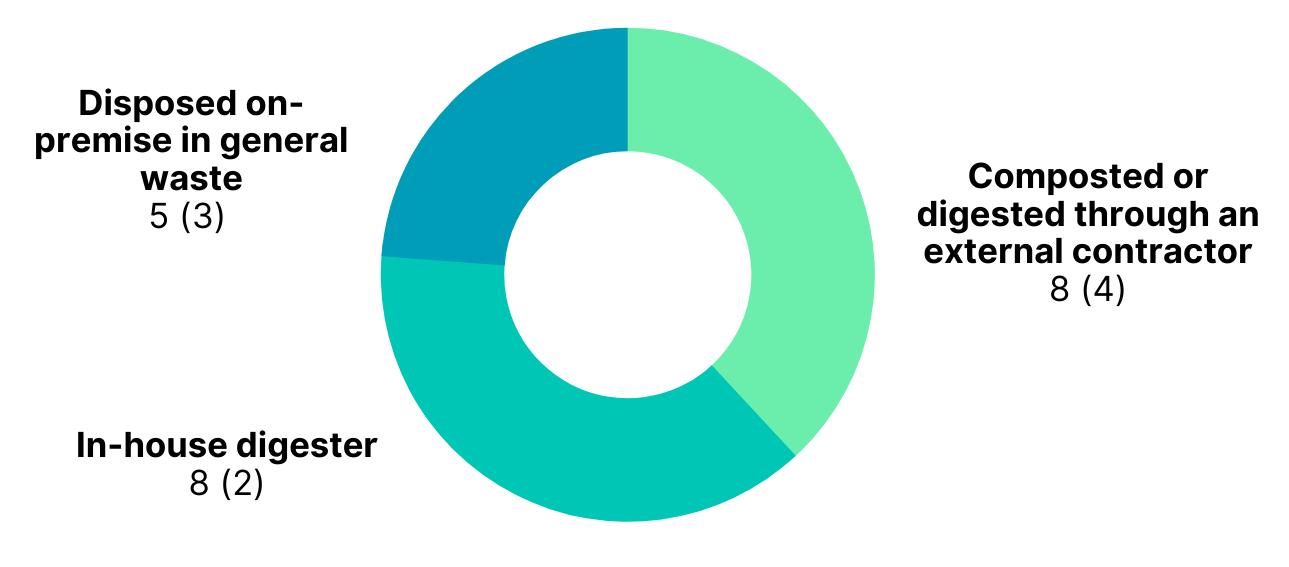
Contrary to SFP waste management where environmental considerations were the most important factors, the choice of a particular food waste disposal method was mainly driven by a market factor: convenience. Among the two main reasons for choosing a particular food waste disposal method, 10 outlets (6 groups) said that “it was the most convenient given the restaurants characteristics (like the size or location of the outlet for example)” and 7 outlets (3 groups) mentioned that “it was easy to integrate in [their] current operation”. Another important consideration for the choice of waste disposal was the environmental aspect of the disposal method: 8 outlets (4 groups) chose their disposal method because “it was the most

environmentally-friendly option” and 6 outlets (4 groups) mentioned that “The method helped [them] monitor / reduce our food waste”. Only one outlet mentioned price as the main reason for choosing a particular food waste disposal method, and that outlet disposed of its food waste in the general trash. One outlet, who also disposed of its food waste in the general trash, also specified that “it was the only method [they] knew of at the time of opening”, which tells a lot about the communication around the readily C available options for food waste disposal for hospitality businesses. HOICE OF DISPOSAL METHOD
Table 6: Motivations for choosing a particular
LANCED BETWEEN CONVENIENCE AND ENVIRONMENTALdisposal method for food waste CONSIDERATIONS
c e e n n i v e C o n
IT WAS EASY TO INTEGRATE IN OUR CURRENT OPERATION
(7/21)
IT WAS THE MOST
ENVIRONMENTALLY-
FRIENDLY OPTION
(8/21)
(6/21)
E n v i r o n m e n t
As such, it seems like, for our sample, the motivations for choosing a particular food waste disposal method were mainly an environmentallyfriendly option that would be easy to integrate in their operations. Among the food waste disposal methods used by our respondents, composting and digestion of organic waste are the two most environmentally-friendly options because of their landfill-diversion capacity as well as their endproduct, which can be used as fertilizer. The two options and their endproduct are slightly different though. A digester uses anaerobic digestion, which is a process through which bacteria break down organic matter in the absence of oxygen38 and turn it into a liquid that can be filtered safely through a 0.5mm screen into existing plumbing infrastructure,39 solid residue that can be used as fertilizer, and biogas. A composter on the other hand uses the natural process of biodegradation and decomposition of organic matter into compost.

Typically, in order to process the amount of food waste generated by a hospitality business, the composter will allow for a more controlled environment where the temperature, carbon and nitrogen ratio, and the balance of air and water are optimized in order to speed up the process.
Out of the 16 outlets (6 groups) who either digested or composted their waste, half of the outlets (8 outlets, 4 groups) used an external contractor for composting or digesting their waste, while the remaining 8 outlets (2 groups) were using an in-house digester. These two groups were hotels, who have the necessary space to have a food waste processing machine.
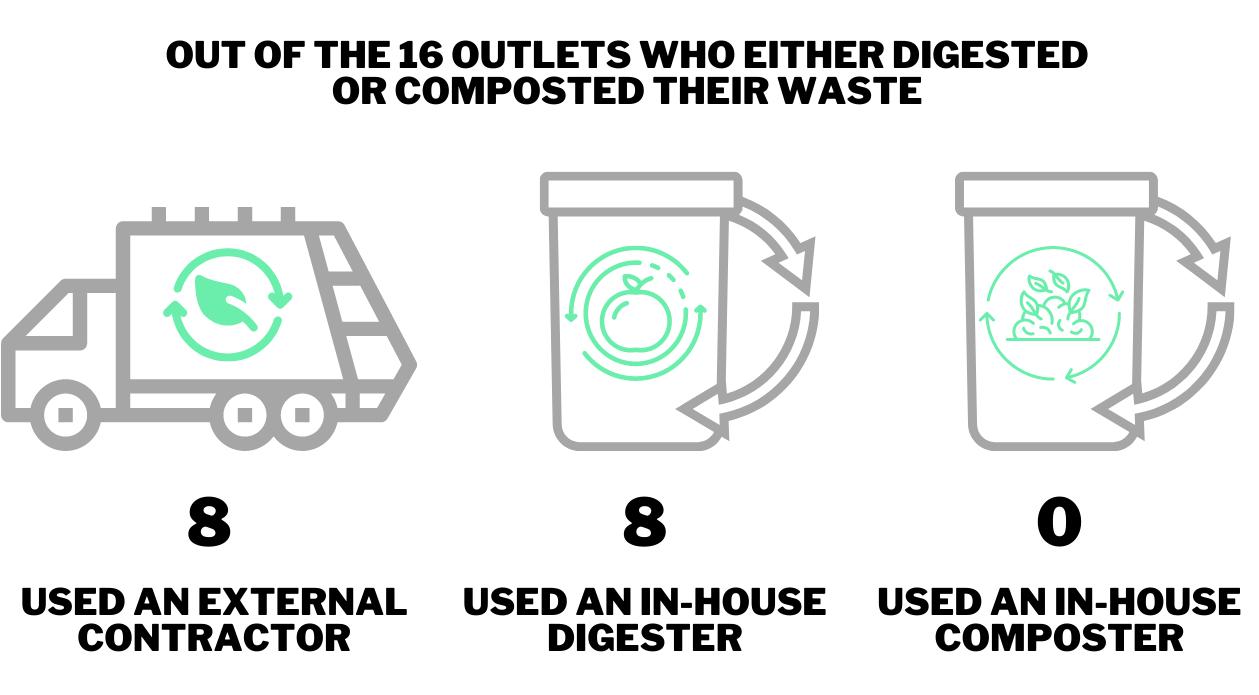
None of the outlets reported using an in-house composter. When asked specifically why they preferred an in-house digester instead of an inhouse composter, they mentioned that “for [their] operation, a digester is more efficient and cleaner” and that “[they] ha[d] no internal needs of using the compost for now”. However, for outlets using a digester, some interviewees mentioned that operating the machine required following special rules and special maintenance treatment. When asked about his experience with the digester they are using, a chef replied: “I do not have too many comments on that machine because I personally don't know how to work with it. [...] But, we have a company who handles and who operates the machine in the basement. [It is] very critical [because the] machine can break easily if people don't follow the right rules.”

2.3 Expectations for improved waste management practices and main barriers for implementation
Despite having a sample that is particularly wary of sustainability in their SFP use and food waste management, we asked our respondents to provide us insights with what they would see as the three most effective measures that would help them and the hospitality industry improve the waste management of their SFP as well as their food waste.
Below is a summary of the most relevant measures according to them in order to improve SFP waste management and food waste management respectively:
Table 7: Most efficient measures to improve waste management for SFP and food waste (out of 21 outlets)
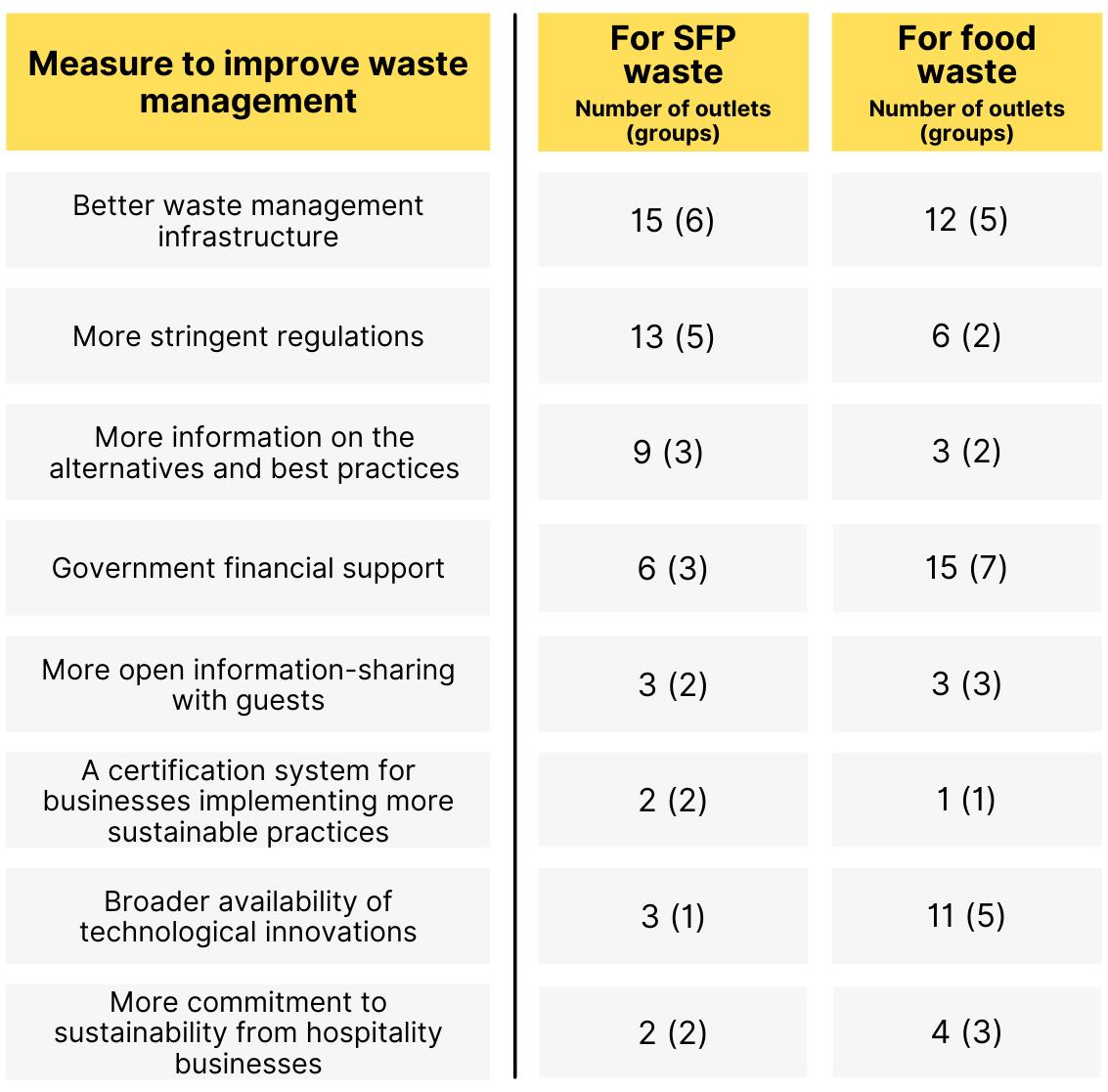


From this table, one can see that the hospitality industry expects a lot more to be done in terms of infrastructures, financial support, and regulations, which are measures that are external to them and that should be taken at a systemic and territory-wide level.
Both for SFP and food waste management, outlets agreed that the ex-
isting waste management infrastructure in Hong Kong was insufficient
and appeared to be the most important improvement to make in order to facilitate waste management practices of the industry. During interviews, several members of the management teams of outlets mentioned that a broader availability of recycling bins for example was needed. They linked it to the fact that, given the lack of space to put recycling bins or food waste bins indoors, there should be more bins available outside and serve several outlets in the vicinity. One restaurant owner actually mentioned that this doesn’t necessarily need to be run by companies contracted by the Government, but by dedicated NGOs like HK Recycles, whose expertise and experience could also be leveraged in order to improve the availability of recycling bins:
“Because you know [...]hotels [for example] always have a designated area where they put their bins for safety and hygiene reasons, but for free-standing restaurants [like us], wherever you have space to put a table you put a table you know! So yeah, it’s a little bit tricky. So if there was a way for the Government to [put more recycling bins] that would be so much more helpful. Or just, you know, letting an NGO like HK Recycles to have massive bins in certain areas [that] only industries or the restaurants that are in this area that can [use] [...]. And then you lock it and you only have the code if you are a restaurant that’s part of this program. I mean that would be ideal.”

The lack of space was also an issue when trying to segregate food waste, and in order to compensate for it, the same outlet was considering the same type of community/neighborhood recycling concept, but for food waste:
“[...] I don’t remember her name but she works for [another restaurant], and she came to see us because I think that they are trying to do some composting, but they might not have enough for composting so they came to us, they asked [our team] if they would be interested [...] to combine it with them,”
said the restaurant owner in an interview.
In terms of the importance and effectiveness of more stringent regulations, outlets expressed different opinions regarding SFP waste management and food waste management (Table 7 above): while 13 outlets (5 groups) thought that it would be one of the 3 most effective measures to implement for SFP waste, only 6 outlets (2 groups) thought so for food waste. Until now, measures that aim to reduce SFP waste have been mainly implemented in Government buildings in a green procurement approach. For example, canteens serving Government employees do not provide plastic straws and polyfoam food containers anymore.40 In July 2021 though, the Government disclosed a plan to regulate the use of disposable plastic tableware. The initiative, targeting a wide range of plastic tableware and taking into consideration disposable items both used for dine-in service and take-away, has been mostly welcomed, despite some criticism related to the timeline of the project,41 whose first phase is scheduled to start around 2025.
Government financial support as well as the need for a broader
availability of technological innovations were cited more often as measures to improve food waste management than SFP management: for improving the hospitality industry’s food waste management practices, 15 outlets (7 groups) were wishing for more financial support and 11 (5 groups) thought that a broader availability of technological innovations was needed. In the case of food waste, technological innovations can refer to smart bins that directly weigh and identify the type of food waste discarded using artificial intelligence. It could also mean more efficient composters or digesters. In all cases, technological innovations are usually costly and, as we will see below, cost is cited by our respondents as one of the main barriers for implementing better food waste management at an outlet or groups’ level.

For SFP, one outlet actually added “Lower cost [for] sustainable packaging” to the suggestions. This could also be an area where financial support could be needed. In the interviews, respondents mentioned
that they would welcome subsidies in order to help them make better
choices in terms of sustainability of their operations. Moreover, as sustainable alternatives are not readily available in Hong Kong, they become harder to reach for smaller businesses. Sustainable alternatives need to be in higher demand to lower the cost, or should be financially supported by the Government, according to interviews. Plastic food containers are expected to be substituted by affordable and available alternatives.
According to our respondents, information sharing from the
Government and other actors in charge of waste management (NGOs, recycling contractors…) about alternative waste management methods and best practices was also insufficient and could be improved in order
to help hospitality businesses implement better practices, especially for SFP waste: 9 outlets (3 groups) mentioned it for SFP waste, and 3 outlets (2 groups) mentioned it for food waste. The campaigns the Government has endorsed so far such as the Food Wise campaign haven’t been successful, according to an outlet operator. The campaign did not offer explanations as to why it is important to reduce food waste, nor offered any kind of monetary incentives such as the establishment economically benefiting from proper food waste management or having monitoring from the Government. “Yeah, it doesn’t work. I haven’t seen anything to be honest. Oftentimes what happens is that the Government sends you a leaflet [...]. We receive so much paper sometimes I’m just like, ‘Can you stop just killing trees?’ But it’s only paper, and there is no real education in the restaurant that is provided,” was mentioned by the operator. The same feeling was apparent when guests were asked about the Food Wise Campaign or any eco-label/campaign present in Hong Kong:

Interviewer: Do you know any eco-labels in Hong Kong? Customer: I think the Government has some sort of certificates for the restaurants saying this is less waste or whatever. Interviewer: Do you mean the Food Wise Campaign? Customer: But I don’t know. I’ve seen the campaign but I don’t know if they have specific stickers or certifications for the restaurants. I’m not sure. Interviewer: Do you know a lot about this campaign or you just know it exists? Customer: I know it exists. Interviewer: But you don’t know exactly what it means, right? Customer: No.
Moreover, sustainability labels, food composting, compostable SFP or food waste reduction measures at the restaurant level were not cited by guests as a decisive factor for visiting a restaurant. If they agreed that the implementation of such practices could somewhat play a role, interviewed guests mostly cited the quality and taste of the food as their main motivation for visiting a particular outlet.



All in all, the expectations of outlets regarding the way to implement better waste management was mirrored by the biggest barriers they identified as impeding better food waste management. They are listed below in Table 8 below:
Table 8: Main barriers of implementation for better food waste management (out of 21 outlets)
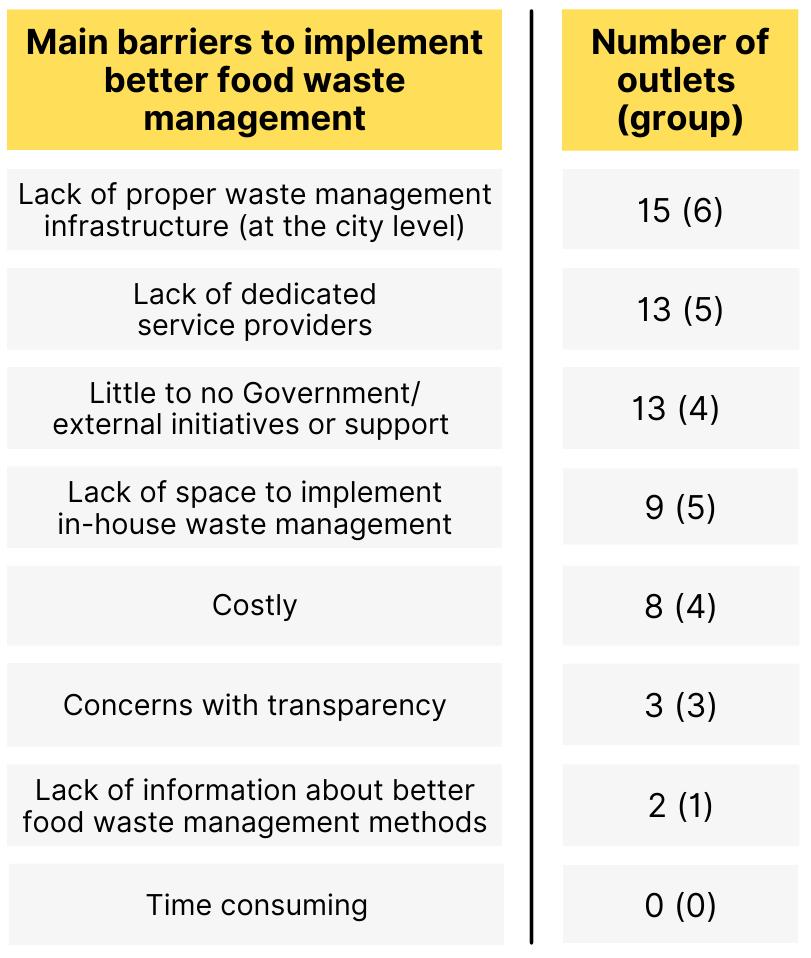
Just like the expectations from the different outlets/groups, most of
these barriers are external to the outlets’ operations and are linked to
the intervention of an external actor, and especially the 3 most frequently cited barriers: “Lack of proper waste management infrastructure (at the city level)”, chosen by 15 outlets (6 groups), “Lack of dedicated service providers (i.e. no suitable waste management contractors)” and “Little to no Government/external initiatives or support (e.g. public collection programs, subsidies)”, both chosen by 13 outlets, and by 5 and 4 groups respectively.

Market factors like the lack of space (which can be interpreted as lack of convenience) or the price were also important barriers in terms of groups, but less in terms
of outlets. This could suggest that smaller groups consider that such
barriers could be overcome with proper waste management infrastructures, more dedicated service providers and more Government/
external initiatives or support. Interestingly, no outlet mentioned the time it takes to implement the food waste management method as one of the main barriers for implementing it.
One group also reaffirmed its need for more information and the perceived lack of options and solutions about better food waste disposal methods: the group that mentioned that “it was the only method [they] knew of at the time of opening” as the reason for their choice of food waste disposal method is also the one who chose “Lack of information about better food waste management methods (we don't know how to do better)”.









